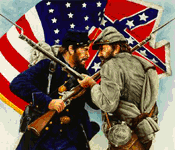 |
Civil War Battles |
|
State War Records |
| AL - AK - AZ - AR - CA - CO - CT - DE - FL - GA - HI - ID - IL - IN - IA - KS - KY - LA - MA - MD - ME - MI - MN - MS - MO - MT - NE - NV - NH - NJ - NM - NY - NC - ND - OH - OK - OR - PA - RI - SC - SD - TN - TX - UT - VT - VA - WA - WV - WI - WY |
The Battle of Ivy Mountain
November 8-9, 1981 in Ivy Mountain, Kentucky
 |
|||||||||||||||||||||
|
Col. John S. Williams, recruiting in southeast Kentucky, had 1,010 raw volunteers gathered around Piketon (or Pikesville), 28 miles southeast of Prestonburg. They ran short of ammunition at Prestonsburg and fell back to Pikeville to replenish their supply. To entrap Williams, Brig. Gen. William Nelson sent Col. Joshua W. Sill from the Louisa area, north-northeast of Prestonburg, south about 38 miles to the east of Piketon to cut off Williams' retreat across the nearby Virginia state line. Sill left louisa late on the morning of November 7th, with a regiment, a small battalion, and some artillery sections, marching straight for Piketon down the open state road. Sill had a larger force and attempted to "turn or cut the Rebels off."
Williams' men, armed with shotguns and flintlocks, were no test for Nelson's force, and Williams only hoped for time to retreat to Virginia. Williams prepared for evacuation and sent out a cavalry force to meet Nelson. Nelson's troops ran into the Confederate cavalry 8 miles from Pikeville.
Williams' cavalry skirmished and withdrew. Undeterred, the Federals marched toward Piketon with great speed. His evacuation incomplete, Williams decided to fight Nelson for a time at a narrow gorge northeast of Piketon where the state road ran between Ivy Creek and the side of Ivy Mountain. As Nelson's force rounded a sharp, blind bend in the road, half of Williams force opened fire on them, in their constricted ranks, beginning a 1-hour-and 20-minute engagement fought mostly with small arms. Nelson's men outnumbered the Confederates, but since the road narrowed at the bend to a width of 7-feet, reinforcements could not be brought up and the artillery could not be effectively deployed.
Neither side gained the bulge. As the shooting started to end, Williams's men felled trees across the road and burned bridges to slow Nelson's pursuing force. The Union force marched 4 miles, then camped in a heavy rain. Night, rain, and obstructions gave Williams time to pull out of Piketon and retreat to Abingdon, Virginia on the 9th. Sill's force from Louisa, too late to cut the retreat, skirmished with the last departing Confederates at Piketon on the 9th, then occupied the village.
This bedraggled Confederate force retreated back into Virginia for recuporation. The Union forces consolidated their power in eastern Kentucky mountains.
